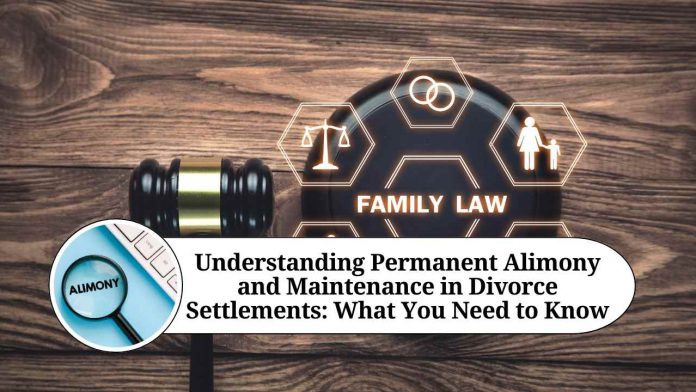Understanding Permanent Alimony and Maintenance
Alimony, also known as spousal support, is a financial payment that one spouse makes to the other spouse after a divorce. It is designed to help the financially weaker spouse maintain their standard of living after the end of the marriage. Permanent alimony, as the name suggests, is a type of alimony that lasts indefinitely. In contrast, maintenance refers to a similar form of financial support, but it is typically awarded for a specific period of time. In this blog, we’ll explore the differences between permanent alimony and maintenance, and how they are awarded in divorce cases.
What is Permanent Alimony?
Permanent alimony is a type of spousal support that is awarded by a court in certain circumstances. It is designed to provide ongoing financial support to a spouse who is unable to support themselves after a divorce. The length of time that permanent alimony lasts can vary depending on the specific circumstances of the case, but it is generally awarded when the marriage was long-lasting and the dependent spouse is unlikely to become self-supporting due to age, disability, or other factors.
Permanent alimony is usually awarded in cases where one spouse has significantly greater earning potential than the other. The amount of permanent alimony awarded is typically based on the dependent spouse’s financial needs and the ability of the other spouse to pay. It is important to note that permanent alimony can be modified or terminated in certain circumstances, such as if the dependent spouse remarries or if the paying spouse experiences a significant change in financial circumstances.
What is Maintenance?
Maintenance is similar to permanent alimony, but it is typically awarded for a specific period of time rather than indefinitely. It is designed to provide financial support to a dependent spouse during a transitional period after a divorce, such as while they are completing their education or searching for a job. Maintenance can also be awarded to a dependent spouse who is caring for young children.
The length of time that maintenance lasts can vary depending on the specific circumstances of the case. In general, it is awarded for a period of time that is deemed necessary for the dependent spouse to become self-supporting. Like permanent alimony, the amount of maintenance awarded is typically based on the dependent spouse’s financial needs and the ability of the other spouse to pay.
How Are Permanent Alimony and Maintenance Determined?
The decision to award permanent alimony or maintenance is ultimately up to the court. When making this decision, the court will consider a variety of factors, including:
- The length of the marriage
- The standard of living during the marriage
- The financial needs and resources of each spouse
- The age, health, and earning capacity of each spouse
- The contributions that each spouse made to the marriage, including homemaking and child-rearing
- The tax consequences of the award
- Any other relevant factors.
Once the court has considered these factors, it will make a determination about whether to award permanent alimony, maintenance, or neither.
It’s important to note that permanent alimony is becoming less common in many jurisdictions. This is partly due to changes in societal norms and expectations regarding gender roles and economic independence. As more women enter the workforce and achieve financial independence, the need for permanent alimony is reduced. However, there are still many cases where permanent alimony is necessary to ensure that the dependent spouse can maintain their standard of living after the end of a long-term marriage.
Maintenance, on the other hand, is often awarded in cases where the dependent spouse needs time to transition to financial independence. For example, if one spouse put their career on hold to raise children during the marriage, they may need financial support while they pursue education or job training to re-enter the workforce. Maintenance can also be awarded to a spouse who has health issues or other factors that make it difficult for them to become self-supporting.
It’s important to note that the laws surrounding permanent alimony and maintenance can vary widely depending on the jurisdiction. Some states have strict guidelines for determining the amount and duration of spousal support, while others give judges more discretion in making these decisions. In some cases, parties may be able to negotiate the terms of alimony or maintenance through a prenuptial or postnuptial agreement.
Conclusion
In conclusion, permanent alimony and maintenance are both critical components of divorce settlements that help ensure financial stability for both parties. While the laws surrounding these forms of spousal support can vary widely, they are generally awarded based on a variety of factors, including the length of the marriage, the financial needs and resources of each spouse, and the contributions that each spouse made to the marriage. If you are going through a divorce, it’s important to understand your rights and obligations with respect to permanent alimony and maintenance, and to work with an experienced family law attorney to ensure that your interests are protected.
Read more useful content:
Frequently Asked Questions (FAQs)
What is the difference between permanent alimony and maintenance?
Permanent alimony is a form of spousal support that lasts indefinitely, while maintenance is typically awarded for a specific period of time.
How is the amount of permanent alimony or maintenance determined?
The amount of permanent alimony or maintenance is typically based on the financial needs of the dependent spouse and the ability of the other spouse to pay.
Can permanent alimony or maintenance be modified or terminated?
Yes, permanent alimony and maintenance can be modified or terminated in certain circumstances, such as if the dependent spouse remarries or if the paying spouse experiences a significant change in financial circumstances.
Is permanent alimony awarded in every divorce case?
No, permanent alimony is typically awarded only in cases where the marriage was long-lasting and the dependent spouse is unlikely to become self-supporting due to age, disability, or other factors.
How long does maintenance typically last?
The length of maintenance can vary depending on the specific circumstances of the case, but it is usually awarded for a period of time that is deemed necessary for the dependent spouse to become self-supporting.
Can the amount of permanent alimony or maintenance be changed after it is awarded?
Yes, the amount of permanent alimony or maintenance can be changed if there is a significant change in the financial circumstances of either party.
Can prenuptial or postnuptial agreements address permanent alimony or maintenance?
Yes, prenuptial or postnuptial agreements can include provisions regarding permanent alimony or maintenance, but they must be entered into voluntarily and with full disclosure.
What factors are considered when determining whether to award permanent alimony or maintenance?
The court will consider a variety of factors, including the length of the marriage, the standard of living during the marriage, the financial needs and resources of each spouse, and the contributions that each spouse made to the marriage.
Are there tax implications for permanent alimony or maintenance?
Yes, the tax implications of permanent alimony or maintenance can be complex, and it’s important to consult with a tax professional to understand how these payments will be treated for tax purposes.
Can a spouse who is receiving permanent alimony or maintenance remarry without affecting their support payments?
It depends on the specific terms of the divorce settlement. In some cases, remarriage can terminate the obligation to pay spousal support, while in other cases, the payments may continue even after remarriage. It’s important to consult with an attorney to understand the specific terms of your divorce settlement.




















